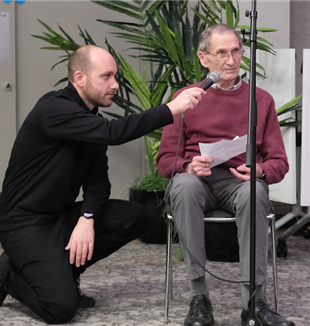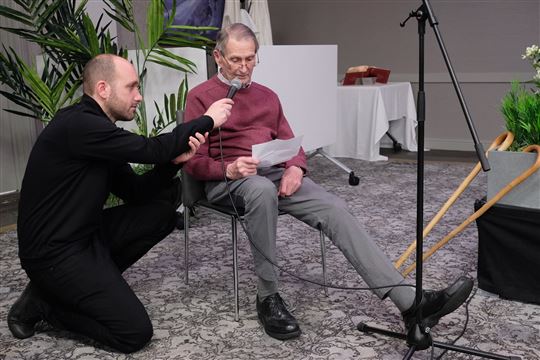
“What I have been looking for all my life”
John, now 85 years old, became a Catholic at 22. After meeting the movement of Communion and Liberation 13 months ago, he says, “I have received a whole new understanding of what it is to be a Christian.”“As Fr. Giussani expressed, the last year has seemed liked the opening of a golden age for me. I have received a whole new understanding of what it is to be a Christian.” John Williams, 85 years old, became a Catholic at the age of 22 and, 13 months ago, he met the movement of Communion and Liberation. Last weekend, in front of Fr. Carrón and 400 people from the European English-speaking communities, he shared his experience of the value of the movement for his life.
John has lived in Eastleigh, a small British railway town northeast of Southampton, for 30 years. 16 months ago, two priests from the Fraternity of Saint Charles Borromeo moved to live in his parish rectory, having been entrusted the parish district of Saint Swithun Wells. A School of Community group already met in the nearby city of Southampton, whose members the newly settled priests invited in order to speak to their parishioners about CL. John recalls his response: “When Giacomo came and explained what the movement was all about, which I knew nothing about before, I thought that this is what I had been looking for all my life. I immediately joined Giacomo’s group and found them to be, of course, totally Catholic, but living a Christian way of life in a manner like no other I have experienced.”
Raised an Anglican, John had no contact with Catholics until the age of 20, until he met the girl who turned out to be his wife. He recalls, “I met her at a dance, just before my 21st birthday, for which we had a party and I invited her. Afterwards, my sister told me that my father had pointed out to my mother that this was the woman I was going to marry. There was immediately something about her and the way she was. We were blessed with 54 years of marriage until 6 years ago, and 4 children. Her faith never wavered and she would have embraced this new way of life, had that been granted”. Even before meeting his wife, John recounts how he had begun to question his faith: “I was really down to basics: if there is a God, surely there is only one church? I had come to the conclusion that if I was going to go further, this was going to be my root. She took me to mass, of course, and it was immediately quite acceptable to me to follow her and see what she was up to. So it all fell into place”. A year later, John was received into the Catholic church. 
John explains how he has been looking for this “something” all his life. He says, “[a]ll this time, whenever there was anything going on to deepen my faith I have always been a part of it. I have belonged to prayer groups and I took part in the Alpha course. This was 10 years ago or so, when people were beginning to talk about their faith. But that did not take off. Ever since then, I have been looking for something like this to come into the parish. We really needed something for the whole parish to be involved in to discuss faith. And I met the movement.”
Now part of the Southampton School of Community, John talks about the “pleasure and fulfilment of following the path of the movement and the guidance of Fr. Giussani’s writings, which “are sometimes a challenge but always fulfilling and uphold all that is good and essential about the Church that Christ founded”. The significance of School of Community for him and his certainty in it being something useful for his life is evident through his attempts to immediately to reach out to others. He states, “[t]his May, we made a presentation in the parish about it. Those who were interested were invited to come, so there were only about 40 people. But it was enough. I could see that there were people there that would listen. And it worked. I helped make the presentation only three months after I became involved. I was so convinced that this was an opportunity for the parish. I do, however, have a worry that it will be quite a challenge to build on the example and legacy of our Borromeo priests, but it is happening across the world so I am optimistic. These priests are involving themselves with parishioners and children, especially, are being invigorated. And these priests just live as they should, with the people.”
Still today, 62 years after his conversion, John is still re-discovering his familiarity with Christ: “I have discovered that, unwittingly, I had drifted into the Protestant concept of the figure of Christ as a system which, as Pope Francis has said, ‘can risk seeing Jesus Christ simply as a fine model from the distant past, as a memory, as someone who saved us 2000 years ago. But that would be of no use to us: it would leave us unchanged, it would not set us free’.” These words of Pope Francis have struck a chord with John who is thankful to Fr. Giussani for “constantly bringing us back to the challenge of what began with Christ risen and, therefore, Christ present. His presence is not deferred until after death, in the beyond, but exists now.” John’s perception is that Catholics of CL “are crystal clear about this and find it difficult to understand why, until the recent past, I personally have been unable to experience Christ in my life. That true change in faith is recognition of his presence now. I can attest that Catholics in general very often need help in recognising Jesus in their lives”.
John tells us how this past year was also marked by the loss of his 92-year-old sister who, like him, had also converted from Anglicanism, being received into the Catholic Church late in life, at the age of 90. He says, “[t]he reason why she came to it late in life is that she was an Anglican all her life, but she was always open. When at an early age in our lives I became a Catholic, we would talk about it from time to time and it was clear that she was considering becoming Catholic.” However, leading a group of Anglicans in Portsmouth, she felt unable to abandon her people and only entered the church towards the end of her life. Speaking warmly of his sister, John is grateful to have had the possibility “to share the journey of her difficult and painful 6 weeks in hospital with my community”. Her illness was also a period for him to grow deeper in prayer and he recounts specifically how “there was one occasion when I was enable to say, and testify to them, that a particular heart-felt prayer had been answered. Until this happened, my faith in prayer was, at best, conditional.”
John speaks to us beaming and full of gratitude for the “wonderful” weekend spent with Fr. Carrón: “I see that this is one of the basic things you need, so I came”. The experience of this weekend, however, also poses him a challenge: “I have four lovely children, and none of them are practising Catholics. One of the things that I am struggling with is, what is it that I am doing wrong? And I had sort of just given up on it, but now I realise that I must not give up and they do not even know I am here. I am going to tell them that I came here and how good it was for me, and that might open up a chink.”
John’s story is one of following; first the faith of his wife and, now, this new path set out by Fr. Giussani, in search of that “something” missing. In front of Carron and friends of the movement John adds two further discoveries he is making upon this path: “Christianity is not a doctrine or laws but an event and everything else is a consequence. It is an event and not just our thoughts. The reason why the Church flourished immediately after the resurrection is that they felt His presence among them”.